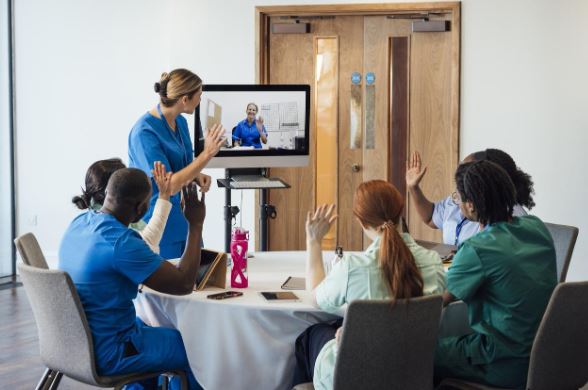How FNPs are leveraging digital technology in patient care
Digital technology is changing healthcare systems for the better, and these transformations are happening rapidly in facilities across the nation. From electronic health records to wearables and telehealth, innovations are changing the way that patients engage with their health and how practitioners deliver medical care.
A more efficient way of providing care
Today, understanding how to use health tech is part of standard nursing procedures. It is expected that purposefully adopting new practices will enhance patient outcomes, improve accuracy and make healthcare more accessible. Technology is facilitating these aims by reducing costs, making systems more reliable, and improving safety standards for both health workers and patients. In its Global Strategy on Digital Health, the World Health Organization asserts that digital health will play a crucial role in tackling health disparities.
It’s not just about tools and gadgets, because health tech offers numerous solutions that improve the management of hospitals and allow for the development of better treatments. It’s an exciting time to be in the profession, and many registered nurses (RNs) are inspired by the potential of digital healthcare. For those who want to be at the forefront of its delivery now and in the years to come, a family nurse practitioner (FNP) route is ideal. In this more responsible role, they can expect more autonomy, excellent career prospects, and a great degree of personal satisfaction. Although training for an advanced qualification can be challenging for any healthcare worker, the new remote learning programs at universities such as Spring Arbor have made this form of professional development more accessible.
The RN to MSN Family Nurse Practitioner program at Spring Arbor University is a flexible course that enables working practitioners to move from an RN to FNP position in just 2.5 years. It offers a thorough grounding in medical leadership, advanced nursing and population-specific healthcare. Once they qualify, new FNPs will utilize technology to refine their decision-making, offer remote interventions and deliver cost-effective care. Here’s a closer look at some of the solutions they are likely to integrate into their daily practice.
Reaching out to more patients with telehealth and telemedicine
The COVID-19 pandemic represented a watershed for telehealth, as patients and healthcare providers had to find new ways of interacting. A study carried out by the US Department of Health and Human Services (HHS) found that in 2019 around 840,000 people had a remote Medicare visit, but by 2020 that number had increased to 52.7 million.
FNPs who incorporate telehealth into their practice use various forms of technology to deliver these remote services. As more and more people have access to the internet, personal computers and mobile phones, online consultations have grown in popularity. It’s a useful solution for people who are housebound, those who would risk their health by coming into a crowded surgery, and also patients who live in very rural locations. As people do not have to find transport to and from the clinic, and their appointments take up less time, this is a cheaper option for the patient. According to the FDA, cost-effectiveness is one of the key benefits of digital healthcare, as disease prevention, detection and treatment become more accessible and effective.
Digital solutions are transforming how patients access care, because they also give patients more autonomy. FNPs can offer online portals for people to independently schedule or reschedule a meeting, or cancel one altogether. This cuts down on the resources that an organization needs for patient-facing work and provides patients with more flexibility. Even if a patient does have an initial appointment at a clinic, telehealth can make any follow-up work far simpler. The FNP can monitor the progress of a treatment plan and coordinate any additional care from a third-party provider remotely. Moreover, prescriptions can be requested by the patient and completed by the clinician remotely, and there any many services that will deliver medications. Finally, patients can play a more proactive part in their care by using the portal provided by their clinic to view their medical records, search for information and read their test results.
Organizing patient information with electronic health records
Traditionally, a patient’s medical history was made up of handwritten notes that were placed into a paper wallet. Frequently, when pages were lost or destroyed, either through an accident or because a patient moved around the country, staff would lose access to vital details. In other cases, they might have had to request information verbally from colleagues who had previously treated their patients. However, this meant that it was easier for mistakes to happen, both in the transfer of important information and in the keeping of records.
Over the last few decades, the adoption of computerized systems in healthcare facilities has changed all this. Today, the vast majority of FNPs in hospitals or clinics will use electronic health records (EHRs) to record and share as much information as possible about each patient in their care. Although EHRs are essentially a single digital document, they can store huge amounts of data about a patient’s health, and their medical history. This could include key facts about their medication program, which drugs they have taken previously, the side effects they have experienced, and any allergies the team should be aware of.
This means that digital health notes work as a useful safeguard against medication errors. The software can even deliver an alert should a patient be prescribed a drug that might interact with others. This is far more helpful than relying on a patient to remember their treatment plan. Furthermore, as EHRs are used by every medical professional who is managing a patient’s care, FNPs can review the organizations and individuals who are also involved. They can see any additional medications that were prescribed and communicate with one another to advise of an important change or ask for clarification.
A patient’s EHR will be with them for their entire life and will contain test results, prescriptions, diagnoses and much more. Each new care provider can add and view information, so the chance of something being overlooked is reduced and patient care is optimized.
Monitoring patients through wearables and apps
FNPs can provide patients with a range of wearables that gather information on their health, or aspects of it. These include ECG and blood pressure monitors, smartwatches and fitness trackers. The data can be sent to the FNP in real time, along with alerts should a patient’s condition appear to worsen. This can be of use when a chronic illness needs managing, the patient is starting an exercise plan, or the FNP is simply trying to identify a trend that might help with a diagnosis.
Patients with an underlying health condition can often be regular visitors to the ER room, which puts pressure on an already strained health system. However, with the assistance of wearables, FNPs can ensure that people get the treatment and preventive care they need. This not only cuts back on readmissions but also ensures that the condition is managed well and the patient does not deteriorate. One of the most useful solutions that wearables can provide in these situations is real-time alerts. These are an aspect of wearable tech that uses biosensors to monitor a patient’s vital signs – if they are chronically ill or recovering from surgery. Even when the patient is back home, the device measures metrics such as their respiratory rate, blood pressure and more. This is transmitted to their FNP who can analyze the readings and intervene whenever necessary.
Health technologies such as these offer a patient comfort and support, even when they are alone and far away from their clinician. The feedback produced enhances communication between patients and their FNP, allowing the nurse to make informed decisions and gain a better idea of what care is needed. For patients, wearables provide a similar service. They offer people the opportunity to understand which lifestyle choices can impact their health, and can even deliver recommendations regarding sleep, healthy eating and stress management.
A swifter, more accurate diagnosis with AI
Artificial intelligence (AI) is a form of digital technology that uses algorithms to sift through vast amounts of medical data and then provide answers to preset questions. AI has been around since the 1950s, offering enhanced computer processing for various applications. In recent years, its use in the field of medicine has had a considerable impact. As well as assisting in the development of crucial vaccines, it can analyze the enormous amounts of information that has been collected by medical facilities and use it to make predictions. These could be related to the types of patients who may be at risk of a certain condition or the early symptoms that frequently lead to a condition taking hold. AI is also useful for practitioners in saving them time on repetitive processes that require in-depth knowledge.
Often, AI is used in combination with the input of an FNP or other medical professional to improve testing results. Breast cancer screening is a frequently used example of this, as AI can carry out a far deeper analysis of mammograms than the human eye and identify precursors that often lead to this form of cancer developing. As a result, FNPs can make sure that their patients receive additional and follow-up testing to ensure that the disease is managed before it can take hold.
For FNPs working in busy hospitals, AI has a different but equally valuable function. Using trackers connected to a central piece of software, the team can track the location of various pieces of medical equipment, and save time on searching for the devices they need. This is especially useful in a ward or department that has lots of patients, as nurses will often use a device bedside, and then be called away to complete another task and forget to return the item to its base.
Improving efficiency with smart hospital management systems
Smart technologies in a hospital empower FNPs and other members of the senior healthcare team to deliver better patient experiences. Often driven by the Internet of Things, these devices can track the maintenance and usage of equipment to help lower costs, without impacting the standard of care provided. Furthermore, smart digital platforms can connect clinical staff, the facility’s leaders and other care workers. This makes it easier for them to establish reliable details on bed occupancy, supply counts and other forms of operational data.
In terms of communication, smart devices and apps can enable staff to send or receive messages from wherever they are in the facility and also to share confidential information securely. Moreover, when an FNP is needed, they can be contacted immediately, and as a result, will respond quickly to an emergency.
Smart tech is also beginning to play more of a role in bedside care. FNPs can use patient monitoring devices to continually observe vital signs without disrupting any of their other tasks. Smart monitors not only record information, but can also be programmed with a series of parameters. Therefore, these devices recognize changes in the patient’s vital signs and immediately inform the FNP. For the patient, there’s a greater quality of care, because if they need treatment, a clinician will arrive to provide it. For an FNP, monitors provide the opportunity to prioritize their bedside visits and also to review their initial diagnosis, if a patient does not seem to be responding well to treatment.
FNPs will continue to deliver effective digital healthcare
Everyone in the US will interact with the healthcare system during their lifetime, and for many the first point of contact will be a primary care professional, such as an FNP. Therefore, FNPs will continue to play an important role in launching these new, more responsive models of care in more personalized ways that fit in with the lifestyles of their patients. For FNPs and other clinicians, digital tech offers convenience and support, the potential for collaborations, access to health analytics and real-time information on each patient they engage with. In combining technology with their knowledge and experience, FNPs are creating a healthcare system in which everyone stands to benefit, both patients and practitioners.




